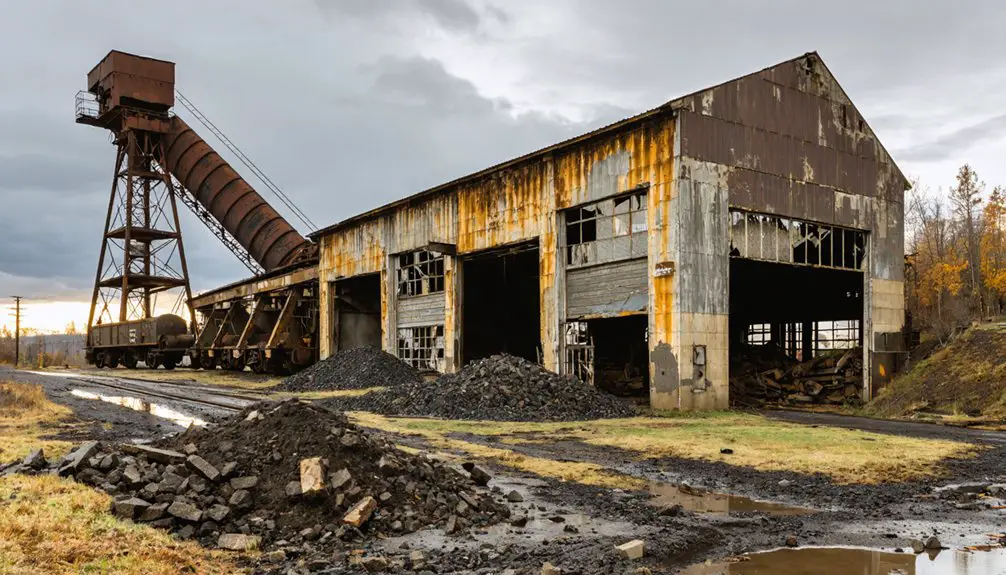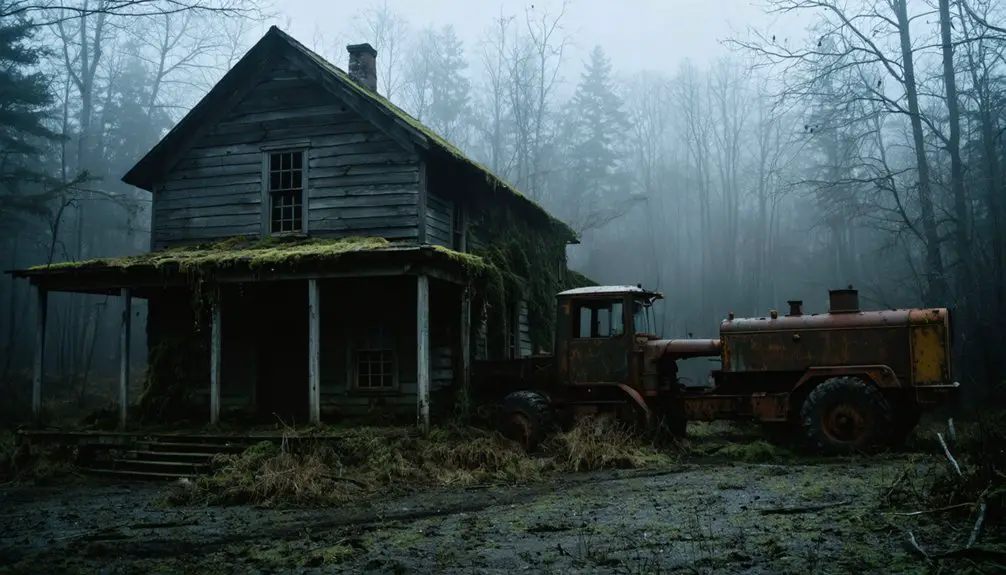You’ll find Helvetia’s haunting remains in Brady Township, Clearfield County, where Adrian Iselin established this coal mining town in 1891. During its peak, the town boasted modern amenities like electricity, schools, and a power plant, producing up to 6,000 tons of coal daily by 1917. After the mines closed in 1954, Helvetia’s families departed, leaving behind crumbling foundations and an old general store – silent witnesses to a once-thriving industrial empire’s dramatic rise and fall.
Key Takeaways
- Helvetia was established in the 1890s as a coal mining town by Adrian Iselin, featuring a coal plant and worker housing.
- The town peaked during WWI, producing 6,000 tons of coal by 1917 with advanced facilities and rail connections.
- Mining operations drastically declined, causing mass exodus of workers and families, leading to the town’s abandonment.
- Few original structures remain today, primarily the old power plant and general store among scattered building foundations.
- Dense forest growth now covers much of the former town site, with only historical markers commemorating its mining legacy.
The Birth of a Mining Empire
When wealthy New York banker Adrian Iselin purchased land in Brady Township, Clearfield County in the early 1890s, he laid the foundation for what would become one of Pennsylvania’s most significant mining operations.
By late 1890, you’d have witnessed the rapid development of essential infrastructure, including a coal plant, worker housing, and company offices. The mining legacy began in earnest by 1891, with coal production established the following year. Similar to how Abundantia allegories appeared in early Swiss illustrations, the town’s prosperity became a symbol of industrial achievement.
Under the Rochester and Pittsburgh Coal Company’s ownership, Helvetia’s economic impact grew dramatically. With bituminous coal deposits fueling its growth, the mine became one of the region’s largest operations.
The R&P Coal Company transformed Helvetia into a powerhouse of economic growth and industrial prosperity in Pennsylvania’s mining region.
The town flourished with modern amenities unusual for its time, including a power plant providing electricity, schools, churches, and general stores. The operation expanded to include blacksmith shops, a steam saw mill, and by 1895, 28 productive coke ovens.
Life in a Company Coal Town
Your daily life in Helvetia’s company coal town revolved around the strict schedules of mine shifts, with families rising before dawn to prepare meals and tend to household duties.
You’d find support through your neighbors, often fellow immigrants who shared your language and customs, creating informal networks for childcare and meal-sharing. Living conditions were especially difficult in the basic laborers’ dwellings that lacked modern amenities.
Your ethnic church and cultural traditions provided essential community bonds, helping you navigate the challenges of life under company control. Like many other patch-towns of the era, the community grew alongside the mining company’s operations.
Daily Routines and Duties
Life in Helvetia’s company coal town revolved around the harsh demands of mining labor, with workers rising before dawn to begin grueling 10-hour shifts underground.
You’d start your daily rituals by heading to the mine shaft, equipped with minimal safety gear, to face dangers like cave-ins and toxic gases. The darkness and coal dust would become your constant companions as you cut, loaded, and hauled coal through cramped passages. The constant exposure to coal dust and poor ventilation meant many workers developed black lung disease over time. Like many patch town residents, you relied completely on company-provided housing and basic necessities.
After your shift, you’d return to your modest company-owned home, where family dynamics centered on rest and recovery.
Your wife would prepare simple meals while managing household duties, and your children would help with basic chores. You’d spend quiet evenings at home, conserving energy for tomorrow’s labor, before retiring early to your bed, knowing another demanding day awaited at dawn.
Community Support Systems
Beyond the daily grind of mining labor, Helvetia’s company-built infrastructure formed the backbone of community life. You’d find essential services like schools, churches, and a power plant that kept both homes and mining operations running. The general store provided vital supplies and served as a central gathering point for the town’s residents.
The company hospital tended to injured miners, while paved streets and sidewalks set Helvetia apart from typical dusty coal towns.
Churches served as pillars of community cohesion, with religious leaders fostering spiritual bonds that often outlasted the mines themselves. You could attend regular social gatherings that strengthened ties between mining families, creating support networks vital for survival.
When tragedy struck – and it did, with 35 documented fatalities between 1892 and 1954 – these community bonds proved invaluable. Memorial sites stood as lasting reminders of shared sacrifices and collective resilience.
Industrial Peak and World War I Impact
While Helvetia started as a modest mining settlement in the early 1890s, it quickly transformed into one of the region’s most prominent coal mining hubs under Adrian Iselin’s leadership.
By 1892, you’d find a bustling industrial complex complete with blacksmith shops, steam sawmills, and extensive processing facilities that marked Helvetia’s rise to power in the Reynoldsville coalfield.
When World War I erupted, Helvetia’s significance skyrocketed. The war economy demanded unprecedented coal production, and the mine secured valuable contracts with the U.S. and Allied governments.
You’ll find records showing the mine’s output reached new heights during this period, though the prosperity came at a cost – dangerous working conditions claimed at least 35 miners’ lives between 1892 and 1954. The mine’s daily production capacity reached an impressive 6,000 tons by 1917.
Architecture and Community Planning
The architectural vision of Helvetia stood apart from typical mining settlements of its era. You’d find carefully planned streets separating industrial zones from living spaces, with cement sidewalks that showcased the town’s commitment to cleanliness and durability – a rare feature in mining communities.
The urban design balanced functionality with livability. While miners’ homes were modest, the town’s architectural significance shone through its community buildings. Churches, schools, and stores were thoughtfully positioned to create a cohesive environment, with open spaces that helped avoid the dreary atmosphere common to coal towns. The town’s eventual fate mirrored many others as its population experienced a dramatic decline to less than one-fifth of its peak.
The power plant’s industrial architecture dominated the landscape, supporting both mining operations and town electricity. Though most structures haven’t survived, the remaining church and industrial relics still tell the story of Helvetia’s distinctive planning approach. Located in Clearfield County, Helvetia’s remnants include its company store building, which stands as a testament to the town’s economic organization.
The Final Days of Mining Operations

During three pivotal decades, Helvetia’s mining operations navigated shifting ownership and declining production that would ultimately seal its fate.
In 1947, Rochester and Pittsburgh Coal and Iron Company sold the mine to Kovalchick Salvage Company, marking the beginning of its final operations. You’d have seen dramatic changes as post-WWII energy markets shifted away from deep mining, causing many miners and their families to leave town.
The workforce that once flourished at 350 strong dwindled as mining decline took hold. Despite having advanced facilities, including a power plant and efficient rail connections, Helvetia couldn’t survive the changing times.
Remembering Helvetia Today
While you’ll find few official memorial sites in Helvetia today, the old power plant stands as the most prominent physical reminder of the town’s mining legacy.
Local historians and remaining residents work to document the area’s past through photographs and written accounts, though no formal preservation society exists.
You can still spot scattered foundations and remnants of the original town infrastructure among the dense woods, but most buildings have succumbed to time and nature.
Memorial Sites Today
Despite Helvetia’s transformation into a ghost town, memorial markers and sites throughout the area preserve its rich mining heritage.
You’ll find historical markers at the old town boundaries, while plaques commemorate the 35 miners who lost their lives between 1892 and 1954. The memorial significance extends to the Odd Fellow Cemetery, where gravestones tell the stories of past residents and mining disasters.
Local historical societies maintain informational displays about the town’s vital role during World War I.
Through historical preservation efforts, volunteers protect these sacred spaces, including the church where memorial services still take place. Digital archives and vintage photographs complement the physical monuments, while private property owners maintain surviving structures, allowing you to connect with Helvetia’s industrial legacy.
Preserving Remaining Buildings
Today’s remaining buildings in Helvetia stand as fragile links to its mining past. You’ll find a privately-owned general store and old power plant among the few structures still standing, though they’re increasingly threatened by nature’s steady advance.
The Amish owners who purchased the 200-acre site in 2020 maintain limited building maintenance of these historic properties.
The power plant’s interior remains partially accessible, though its crumbling staircases demand caution. Dense forest growth challenges preservation strategies, making spring and fall the best seasons for structural assessment.
Unlike other Pennsylvania ghost towns with public preservation programs, Helvetia’s buildings lack formal protection or interpretive signage. While private ownership helps prevent complete deterioration, it also limits public access to these important remnants of the region’s coal mining heritage.
Frequently Asked Questions
Were There Any Major Mining Accidents or Disasters in Helvetia’s History?
While mining safety records show isolated incidents, you won’t find major disasters in Helvetia’s historical accidents – just a documented fatal machinery incident in 1930 and a nonfatal coal-strike injury in 1904.
What Happened to the Residents After the Town Was Abandoned?
Like birds seeking warmer winds, you’d have watched your neighbors scatter to nearby towns after 1954, pursuing new jobs and better lives while some kept their family homes in Helvetia.
Are There Any Ghost Stories or Legends Associated With Helvetia?
You won’t find documented ghostly apparitions or specific local folklore about Helvetia, despite its 35 tragic mining deaths. The town’s eerie abandoned buildings create atmosphere, but verified supernatural stories don’t exist.
Can Visitors Explore the Remaining Buildings and Mine Sites Today?
If you’re hoping to explore Helvetia’s remains, you’ll find visitor access quite limited. Most buildings are privately owned by Amish families, and the mine sites have largely disappeared through strip mining activities.
What Was the Peak Population of Helvetia During Its Mining Heyday?
You’ll find conflicting accounts, but during the mining boom from the late 1890s through the 1940s, before the population decline, Helvetia likely housed several hundred to low thousands of residents.
References
- https://gantnews.com/2019/10/03/throwback-thursday-helvetia-was-once-a-vibrant-mining-town/
- http://discoverypa.blogspot.com/2014/02/helvetia-another-mining-ghost-town.html
- https://en.wikipedia.org/wiki/Helvetia
- https://uncoveringpa.com/ghost-towns-in-pa
- https://www.worldatlas.com/cities/you-won-t-believe-this-town-is-in-pennsylvania.html
- http://iiif.library.cmu.edu/file/Heinz_box00022_fld00006_bdl0005_doc0006/Heinz_box00022_fld00006_bdl0005_doc0006.pdf
- https://www.iup.edu/library/departments/archives/coal/coal-culture-timeline.html
- https://eckleyminersvillage.com/the-village/
- http://libweb1.library.iup.edu/depts/speccol/Coal Culture/Essays/LegacyofCoalMulrooney.pdf
- https://canals.org/2023/12/13/corridor-company-towns/



